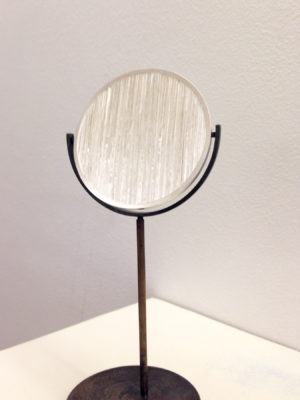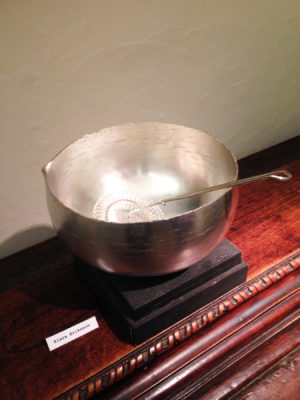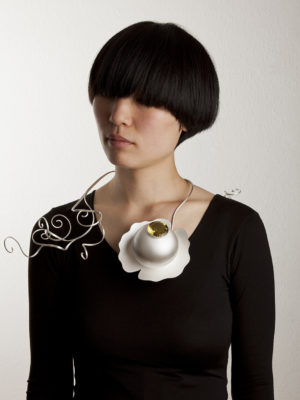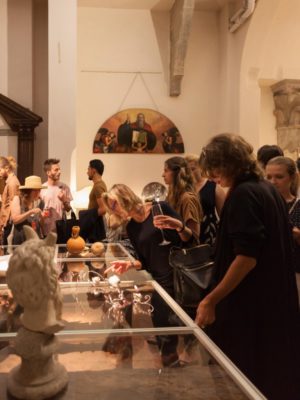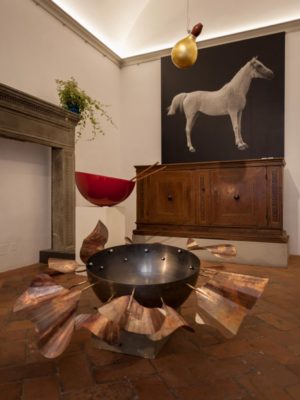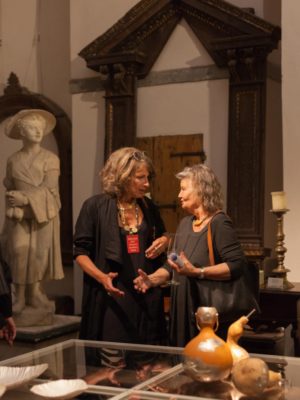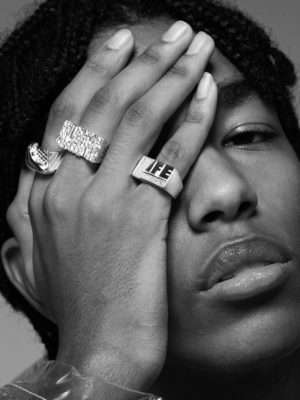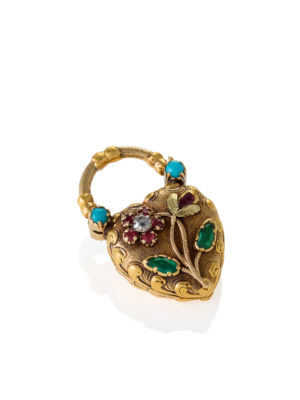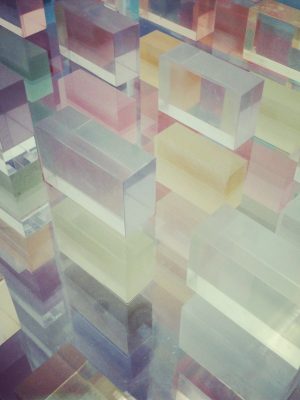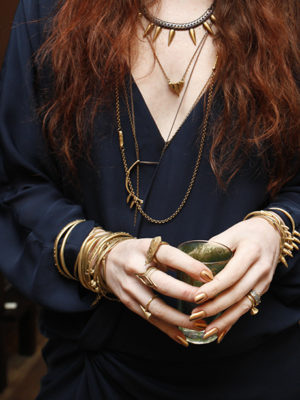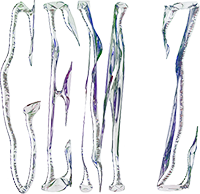Kellie Riggs: As in the case of all the participating artists of the exhibition, Konstfack University Collage of Arts, Crafts and Design was the primary source of their education. There is a particular phenomenon that took place there, which was the evolution of Corpus, which runs parallel to the jewellery education; can you describe what Corpus is to people who may not know?
Inger Wästberg: Corpus – hollow-ware – are objects, which distinguishes itself from other forms of craft, like jewellery. Sweden has a long tradition of Corpus, starting with silver bowls in the medieval churches. The growing middle class of the 1930’s to 1950’s often bought silver vases, coffee sets, and cutlery. It was a way to show status, but it is not so any more.
How is what is being made today connected to the Swedish tradition of silversmithing of Sigurd Persson or Ray Urban –is it still very much in the modernistic Scandinavian design tradition? Or how much of what is going on breaking away from that? How has the idea of function changed in the last 20-30 years as Corpus has developed?
There is a Swedish tradition of aesthetic purity and functionalism, represented by artists like Persson and Sigvard Bernadotte. Today the artists often have a more playful take. They mix silver with other materials and the objects are not always functional. An example is the bowl of Pernilla Sylwan – made of metal with wings of copper, which is playful more than functional. And Tobias Birgersson probably doesn’t think that his fishing-rod hanging over a silver bowl really should be used on a fishing boat or bridge. See it as a sculpture!
Klara Eriksson’s work is a good example of how the idea of function is embedded in what she does; like with her Swedish baking bowl and whisk, which was actually passed around and used if I’m not mistaken. This gesture can be seen as a statement about how the quality of materials may or may effect the flavours of food or use of the object itself for example.
Spoons, candlesticks and such things have always been made for practical use. Klara Eriksson’s baking bowl and whisk are made for use in the kitchen – maybe as a dream from the artist. What a pleasure! To her, silver is not “serious” and it is better used. She wants to show that silver is to be used in many generations, as an everyday luxury and pleasure. And if you can afford an expensive designers handbag you can afford a silver bowl. In practice, however, it is probably not so that someone will buy these objects for quite a sum in order to use them for cooking. So the kitchen objects in silver should be more looked upon as symbolic. At the same time, they raise questions about our habits as consumers. Why are some utensils so inexpensive? Are they produced by child labour? Are they using materials that are not sustainable?
Do you think that traditional craft is experiencing an upswing and becoming culturally important again in a similar way that it was valued, let’s say 50-100 years ago? Both in and out of Sweden?
All over the world sustainability is a priority. That gives craft an upswing. At the same time regrettably, the nationalistic right wing populist parties are lifting up traditional craft as national dividing-lines towards immigrants. Traditional craft, as well as old-fashioned national costumes are brought forward. It’s not bad as such, but when it is used to make cultural walls between newly arrived immigrants and people who have been in the country for generations, it is a misuse of craft and art.
There is this Scandinavian ideal of high quality objects for everyone, right – we saw this in modern silver jewellery design, and in a way, we see this with Ikea – is contemporary silversmithing the antithesis of Ikea though?
Yes and no. IKEA is founded on a Swedish design tradition and distributes inexpensive design all over the world. But the high-end silver corpus objects are of course not for the average consumer. The jewellery of the 1950’s were never bought by the ordinary citizen; only of the rising middle class. It was defined as ”good taste”.
You have a master’s degree in art history and wrote your thesis about contemporary jewellery, is that correct? What is the connection for you between jewellery and silversmithing, or are they separate interests?
Of course they communicate with one another. I was a member of the advisory council of Ädellab – the education at The Stockholm University Collage of Arts, Crafts and Design. Ädellab worked with corpus as well as jewellery. For example, in Florence Petronella Eriksson presented a teapot in the exhibition as well as a necklace and some rings.
Why did you choose this particular group of silversmiths to showcase in your exhibition?
The idea was to expose Corpus, and the artists chosen are all established and well educated. It was a natural group, all part of the LOD collective – a combined gallery and workshop of these seven designers in Stockholm at Kungsholmen since 1999.
You recently were able to curate an exhibition Venice to coincide with the Biennale of Contemporary Art. It’s called Transformations. Could you briefly talk about this project and how it came about? Why was it important for you to take this jewellery to the Biennale?
The Venice exhibit was a follow-up of the Stockholm Jewellery Spring (which was my initiative). Those twenty-one jewellery shows were based on an exhibition by the Swedish National Museum, called “Open Space – Mindmaps. Positions in Contemporary Jewellery”. It was curated by Dr. Ellen Maurer Zilioli who has a background at the Pinakothek der Moderne in Munich and has organized an international jewellery symposium Palazzo Vecchio in Florence, among other things. Parallel with that show, several other museums and galleries arranged jewellery exhibitions that week. The Jewellery Spring dominated the Stockholm art scene for a while. The director of National Museum, Berndt Arell, was in contact with Gabriella Belli at Musei Civici di Venezia, and they decided to make a joint exhibition – “Transformations,” where six artists from Sweden were to be shown: Tobias Alm, Sara Borgegård Älgå, Hanna Hedman, Catarina Hällzon, Märta Mattsson and Agnes Larsson. The idea was to show contemporary jewellery as art, not decoration and not design, in an art context.
What do you want the world to know about contemporary Swedish silversmithing, and jewellery? What does it say to you that is of particular interest?
There are of course different aspects. You can find very successful silver designers. You can see a parallel from when photography changed from mirroring reality to becoming art; what I find especially interesting is that the barriers between jewellery and art are finally breaking down.
Introduction to series:
Florence, Italy, isn’t usually synonymous with contemporary anything – and despite its appreciation for the handmade, and its long history of being an important town for jewellery and goldsmithing (think Ponte Vecchio), contemporary jewellery rather, is still an off-the-beaten path anomaly. But for the last few years, for five days in late spring, it attempts to become Florence’s main attraction via Florence Jewellery Week.
Since 2005 Le Arti Orafe has been presenting PREZIOSA – a cultural initiative with contemporary jewellery at its focus. In 2008 PREZIOSA Young was introduced as well in order to promote the work of talented emerging makers in jewellery. And in recent years LAO’s ambition has expanded even further under the umbrella of FJW. As such, the project has been able to extend their programming that this year involved a two day conference with ten speakers, seven separate exhibitions, four jewellery workshops, various receptions and concerts, and the participation of three independent studios of LAO alumni.
The interview above is part of a short interview series (commissioned by LAO) that aims to shed light on the perspectives of seven of this year’s participants chosen by the author: Curators Kevin Murray and Inger Wästberg, artist Arata Fuchi, and this year’s four PREZIOSA Young winners, Qian Wang, Xiaodai Huang, Fang Yin Yeh, and Shachar Cohen.
